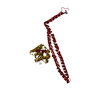[English] 日本語
 Yorodumi
Yorodumi- SASDD56: Artificially designed de novo protein esPN-Block (FL4) heterocomp... -
+ Open data
Open data
- Basic information
Basic information
| Entry | Database: SASBDB / ID: SASDD56 |
|---|---|
 Sample Sample | Artificially designed de novo protein esPN-Block (FL4) heterocomplex, e1s2 (FL4)
|
| Biological species | artificially designed de novo protein (others) de novo protein (others) |
 Citation Citation |  Journal: ACS Synth Biol / Year: 2018 Journal: ACS Synth Biol / Year: 2018Title: Self-Assembling Supramolecular Nanostructures Constructed from de Novo Extender Protein Nanobuilding Blocks. Authors: Naoya Kobayashi / Kouichi Inano / Kenji Sasahara / Takaaki Sato / Keisuke Miyazawa / Takeshi Fukuma / Michael H Hecht / Chihong Song / Kazuyoshi Murata / Ryoichi Arai /   Abstract: The design of novel proteins that self-assemble into supramolecular complexes is important for development in nanobiotechnology and synthetic biology. Recently, we designed and created a protein ...The design of novel proteins that self-assemble into supramolecular complexes is important for development in nanobiotechnology and synthetic biology. Recently, we designed and created a protein nanobuilding block (PN-Block), WA20-foldon, by fusing an intermolecularly folded dimeric de novo WA20 protein and a trimeric foldon domain of T4 phage fibritin (Kobayashi et al., J. Am. Chem. Soc. 2015, 137, 11285). WA20-foldon formed several types of self-assembling nanoarchitectures in multiples of 6-mers, including a barrel-like hexamer and a tetrahedron-like dodecamer. In this study, to construct chain-like polymeric nanostructures, we designed de novo extender protein nanobuilding blocks (ePN-Blocks) by tandemly fusing two de novo binary-patterned WA20 proteins with various linkers. The ePN-Blocks with long helical linkers or flexible linkers were expressed in soluble fractions of Escherichia coli, and the purified ePN-Blocks were analyzed by native PAGE, size exclusion chromatography-multiangle light scattering (SEC-MALS), small-angle X-ray scattering (SAXS), and transmission electron microscopy. These results suggest formation of various structural homo-oligomers. Subsequently, we reconstructed hetero-oligomeric complexes from extender and stopper PN-Blocks by denaturation and refolding. The present SEC-MALS and SAXS analyses show that extender and stopper PN-Block (esPN-Block) heterocomplexes formed different types of extended chain-like conformations depending on their linker types. Moreover, atomic force microscopy imaging in liquid suggests that the esPN-Block heterocomplexes with metal ions further self-assembled into supramolecular nanostructures on mica surfaces. Taken together, the present data demonstrate that the design and construction of self-assembling PN-Blocks using de novo proteins is a useful strategy for building polymeric nanoarchitectures of supramolecular protein complexes. |
 Contact author Contact author |
|
- Structure visualization
Structure visualization
| Structure viewer | Molecule:  Molmil Molmil Jmol/JSmol Jmol/JSmol |
|---|
- Downloads & links
Downloads & links
-Models
| Model #1907 |  Type: dummy / Radius of dummy atoms: 2.75 A / Symmetry  : P1 / Chi-square value: 0.005 / P-value: 0.235109 : P1 / Chi-square value: 0.005 / P-value: 0.235109 Search similar-shape structures of this assembly by Omokage search (details) Search similar-shape structures of this assembly by Omokage search (details) |
|---|---|
| Model #1917 |  Type: atomic Comment: 2-state model: PDB1: e1s2FL4_Cform.pdb, Rg = 27.65 A, w1 = 0.485 Chi-square value: 0.036143182452  Search similar-shape structures of this assembly by Omokage search (details) Search similar-shape structures of this assembly by Omokage search (details) |
| Model #1918 |  Type: atomic Comment: 2-state model: PDB2: e1s2FL4_Vform.pdb Rg = 38.66 A, w2 = 0.515 Chi-square value: 0.036143182452  Search similar-shape structures of this assembly by Omokage search (details) Search similar-shape structures of this assembly by Omokage search (details) |
| Model #1912 |  Type: atomic Comment: MultiFoXS best scoring 5-state model: PDB1, Rg = 39.984, w1 = 0.192 Chi-square value: 0.0125395441575  Search similar-shape structures of this assembly by Omokage search (details) Search similar-shape structures of this assembly by Omokage search (details) |
| Model #1913 |  Type: atomic Comment: MultiFoXS best scoring 5-state model: PDB2, Rg = 27.7957, w2 = 0.180 Chi-square value: 0.0125395441575  Search similar-shape structures of this assembly by Omokage search (details) Search similar-shape structures of this assembly by Omokage search (details) |
| Model #1914 |  Type: atomic Comment: MultiFoXS best scoring 5-state model: PDB3, Rg = 28.2499, w3 = 0.305 Chi-square value: 0.0125395441575  Search similar-shape structures of this assembly by Omokage search (details) Search similar-shape structures of this assembly by Omokage search (details) |
| Model #1915 |  Type: atomic Comment: MultiFoXS best scoring 5-state model: PDB4, Rg = 37.2015, w4 = 0.113 Chi-square value: 0.0125395441575  Search similar-shape structures of this assembly by Omokage search (details) Search similar-shape structures of this assembly by Omokage search (details) |
| Model #1916 |  Type: atomic Comment: MultiFoXS best scoring 5-state model: PDB5, Rg = 43.0539, w5 = 0.210 Chi-square value: 0.0125395441575  Search similar-shape structures of this assembly by Omokage search (details) Search similar-shape structures of this assembly by Omokage search (details) |
- Sample
Sample
 Sample Sample | Name: Artificially designed de novo protein esPN-Block (FL4) heterocomplex, e1s2 (FL4) Specimen concentration: 3.5 mg/ml / Entity id: 1029 / 1039 |
|---|---|
| Buffer | Name: 20 mM HEPES, 100 mM NaCl, 200 mM ArgHCl, 10% glycerol / pH: 7.5 |
| Entity #1029 | Name: sPN-Block (WA20) / Type: protein / Description: stopper PN-Block (WA20) / Formula weight: 12.547 / Num. of mol.: 2 / Source: artificially designed de novo protein Sequence: MYGKLNKLVE HIKELLQQLN KNWHRHQGNL HDMNQQMEQL FQEFQHFMQG NQDDGKLQNM IHEMQQFMNQ VDNHLQSESD TVHHFHNKLQ ELMNNFHHLV HR |
| Entity #1039 | Name: ePN-Block (FL4) / Type: protein / Description: extender PN-Block (FL4) / Formula weight: 26.879 / Num. of mol.: 1 / Source: de novo protein Sequence: MYGKLNKLVE HIKELLQQLN KNWHRHQGNL HDMNQQMEQL FQEFQHFMQG NQDDGKLQNM IHEMQQFMNQ VDNHLQSESD TVHHFHNKLQ ELMNNFHHLV HRKLSGGGGS GGGGSGGGGS GGGGSAAAMY GKLNKLVEHI KELLQQLNKN WHRHQGNLHD MNQQMEQLFQ ...Sequence: MYGKLNKLVE HIKELLQQLN KNWHRHQGNL HDMNQQMEQL FQEFQHFMQG NQDDGKLQNM IHEMQQFMNQ VDNHLQSESD TVHHFHNKLQ ELMNNFHHLV HRKLSGGGGS GGGGSGGGGS GGGGSAAAMY GKLNKLVEHI KELLQQLNKN WHRHQGNLHD MNQQMEQLFQ EFQHFMQGNQ DDGKLQNMIH EMQQFMNQVD NHLQSESDTV HHFHNKLQEL MNNFHHLVHR |
-Experimental information
| Beam | Instrument name: Photon Factory (PF), High Energy Acceleration Research Organization (KEK) BL-10C City: Tsukuba / 国: Japan  / Type of source: X-ray synchrotron / Type of source: X-ray synchrotron Synchrotron / Wavelength: 0.1488 Å / Dist. spec. to detc.: 1.06 mm Synchrotron / Wavelength: 0.1488 Å / Dist. spec. to detc.: 1.06 mm | ||||||||||||||||||||||||||||||
|---|---|---|---|---|---|---|---|---|---|---|---|---|---|---|---|---|---|---|---|---|---|---|---|---|---|---|---|---|---|---|---|
| Detector | Name: Pilatus3 2M / Pixsize x: 0.172 mm | ||||||||||||||||||||||||||||||
| Scan | Measurement date: Dec 19, 2014 / Cell temperature: 20 °C / Exposure time: 5 sec. / Number of frames: 30 / Unit: 1/nm /
| ||||||||||||||||||||||||||||||
| Distance distribution function P(R) |
| ||||||||||||||||||||||||||||||
| Result |
|
 Movie
Movie Controller
Controller

 SASDD56
SASDD56





